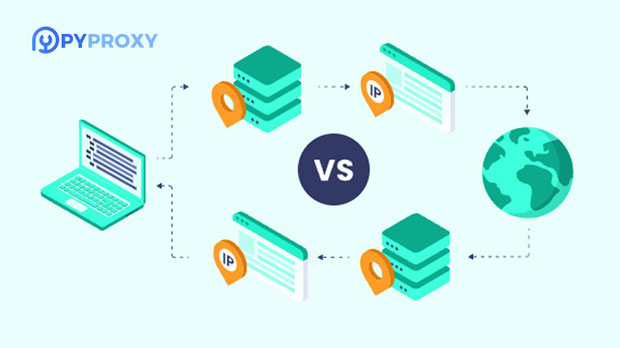In the era of digital marketing, social media management has become a crucial task for businesses and individuals alike. Managing social media platforms such as Facebook, Instagram, and TikTok effectively often requires overcoming geo-restrictions, avoiding IP bans, and maintaining privacy. For these purposes, proxies have become indispensable tools. Two popular proxies, PYPROXY and FoxyProxy, offer distinct features and benefits. In this article, we will analyze and compare the two proxies to determine which is better suited for social media management on platforms like Facebook, Instagram, and TikTok. We will discuss their technical specifications, performance, and how they can address the unique challenges faced in social media management. Understanding Proxies and Their Importance in Social Media ManagementProxies are intermediaries that sit between a user's device and the internet, masking the user’s real IP address and routing traffic through a remote server. This function is especially beneficial for social media managers, as it allows them to manage multiple accounts without triggering security measures like IP bans or CAPTCHA requests.For platforms like Facebook, Instagram, and TikTok, managing multiple accounts or performing bulk actions can sometimes lead to restrictions or bans. Proxies help circumvent these challenges by providing a different IP address for each action, reducing the chances of account suspensions. Additionally, proxies enable geo-location spoofing, allowing social media managers to access region-restricted content or perform actions as if they are in another location.PyProxy: Features and Benefits for Social Media ManagementPyProxy is a flexible proxy solution with a focus on Python integration, making it an attractive option for developers and businesses with technical teams. It supports a range of proxy types, including residential, datacenter, and mobile proxies, each catering to specific needs in social media management.1. residential proxiesResidential proxies are a standout feature of PyProxy, as they assign IP addresses from real residential devices. This is critical for social media management because it helps reduce the likelihood of detection. Platforms like Facebook and Instagram are more likely to flag datacenter IPs as suspicious, but residential proxies are harder to identify as bots. This makes them ideal for tasks that involve logging in to multiple accounts, posting content, or performing automated actions without drawing attention.2. Geo-Location FlexibilityPyProxy allows users to choose proxies from specific locations, providing the ability to bypass geo-restrictions on social media platforms. This is particularly useful for managing international accounts or conducting region-specific campaigns. Social media managers can simulate being in different countries to test regional content performance, access restricted data, or interact with audiences in various regions.3. Automation and API IntegrationFor developers, PyProxy offers strong API integration, making it easier to automate social media management tasks. Businesses can build custom workflows for posting, engaging with followers, or even scraping content. The API allows for easy integration with popular social media management tools, ensuring that proxies seamlessly support your workflows.4. Speed and PerformancePyProxy offers fast speeds and reliable connections, ensuring that social media tasks are performed quickly and efficiently. Speed is crucial when managing multiple accounts or automating actions, as delays can lead to account lockouts or disruptions in campaigns.FoxyProxy: Features and Benefits for Social Media ManagementFoxyProxy is a browser-based proxy extension that is simple to use, making it a great choice for social media managers who prefer a more user-friendly solution. While it lacks some of the advanced features of PyProxy, FoxyProxy has its own set of strengths.1. Browser IntegrationFoxyProxy is a browser extension that integrates directly with popular browsers like Chrome and Firefox. This makes it easy for social media managers to switch proxies while working on social media accounts in their browser. Whether you are managing one account or multiple accounts on Facebook, Instagram, or TikTok, FoxyProxy enables quick proxy switching without the need for complicated setups.2. Customizable Proxy RulesOne of the key features of FoxyProxy is its ability to create custom proxy rules. This flexibility allows users to route traffic from specific websites or applications through different proxies. For social media managers, this means they can configure rules to handle Facebook, Instagram, and TikTok accounts with different proxies, reducing the chances of triggering security measures or bans.3. Simplicity and Ease of UseFoxyProxy is designed for ease of use, making it ideal for social media managers who are not highly technical. The setup process is straightforward, and the user-friendly interface ensures that proxies can be configured and switched with minimal effort. This is particularly useful for individuals or small businesses managing a few accounts, as it eliminates the need for complex configurations.4. Cost-EffectivenessFoxyProxy tends to be more cost-effective than PyProxy, as it is a more basic tool with fewer advanced features. If you are managing only a handful of social media accounts, FoxyProxy might be a more affordable solution. However, its lack of advanced proxy options such as residential proxies may make it less suitable for larger-scale social media management tasks.Comparison of PyProxy and FoxyProxy: Which One is Better for Social Media Management?When comparing PyProxy and FoxyProxy, both proxies have their merits, but the decision largely depends on the scale and complexity of your social media management needs.1. Scale of Social Media ManagementIf you are managing a large number of social media accounts or require automation, PyProxy is the better choice. Its ability to integrate with APIs, provide residential proxies, and support high-speed connections makes it more suited for businesses or teams that need robust and scalable solutions for social media management.On the other hand, if you are managing only a few accounts and require a simple, cost-effective solution, FoxyProxy may be sufficient. Its browser-based integration and ease of use make it ideal for small-scale operations.2. Proxy Types and Geo-Location FlexibilityPyProxy offers a wider range of proxy types, including residential and mobile proxies, which are critical for reducing the likelihood of detection on platforms like Facebook, Instagram, and TikTok. FoxyProxy, while versatile, is limited to using the proxies you configure within your browser and does not offer the same level of flexibility in terms of proxy types or geo-location options.3. Automation and IntegrationFor businesses that need to automate social media management tasks, PyProxy’s API integration and custom workflows provide significant advantages. FoxyProxy, being browser-based, lacks the same level of automation and integration options, making it less suitable for large-scale or automated social media management.4. Ease of UseFoxyProxy is the easier of the two proxies to set up and use, making it ideal for social media managers without a technical background. PyProxy, while more powerful, requires more technical knowledge, especially for API integration and setting up custom workflows.Conclusion: Which Proxy is More Suitable for Social Media Management?Ultimately, the choice between PyProxy and FoxyProxy depends on your specific needs. For large-scale social media management, where automation, proxy flexibility, and geo-location targeting are crucial, PyProxy stands out as the more powerful and versatile option. However, for smaller-scale operations or those requiring an easy-to-use, cost-effective solution, FoxyProxy is a viable choice that offers simplicity and practicality.Choosing the right proxy for social media management is essential for ensuring the security, efficiency, and success of your campaigns.
Mar 28, 2025
![arrow]()




























































